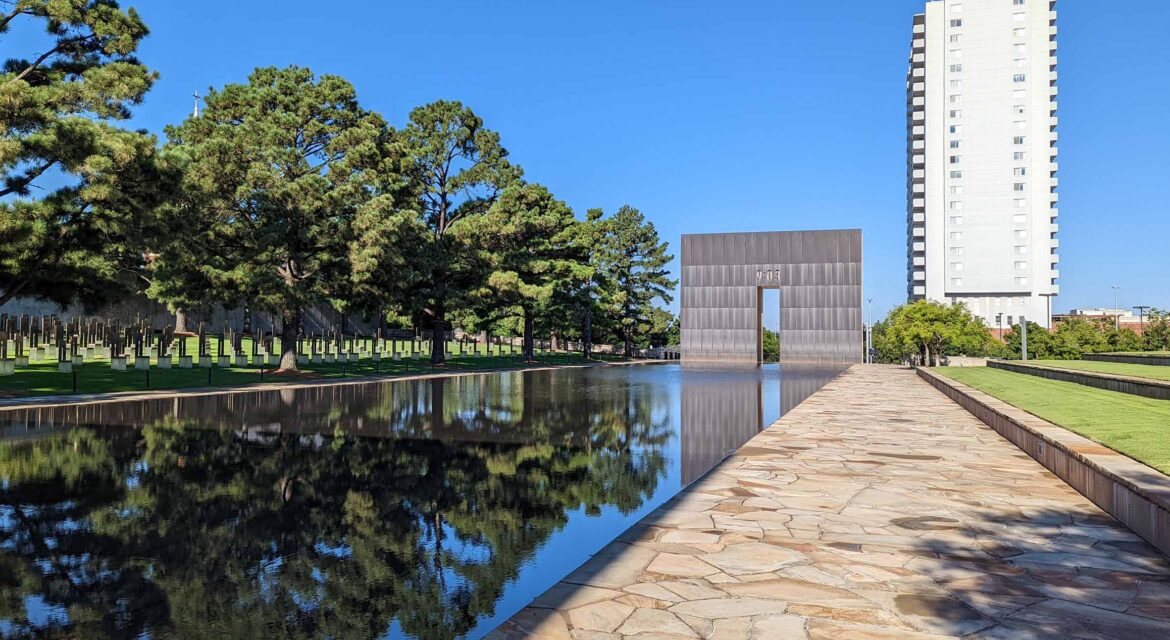 The Oklahoma City bombing changed the lives of countless individuals, numerous communities, and an entire nation. Created to commemorate this tragedy but also allow audiences to uniquely experience its impact, the Oklahoma City National Memorial is located in the literal footprint of the event in downtown Oklahoma City, Oklahoma. The numerous landmarks that it contains showcases how many different types of experiences memorials can cultivate to provide context and understanding for audiences across the eras.
The Oklahoma City bombing changed the lives of countless individuals, numerous communities, and an entire nation. Created to commemorate this tragedy but also allow audiences to uniquely experience its impact, the Oklahoma City National Memorial is located in the literal footprint of the event in downtown Oklahoma City, Oklahoma. The numerous landmarks that it contains showcases how many different types of experiences memorials can cultivate to provide context and understanding for audiences across the eras.

The Field of Empty Chairs, Reflecting Pool, Rescuers’ Orchard and More
 The Alfred P. Murrah Federal Building was a United States federal government complex in Oklahoma City that was the target of a terrorist attack in 1995, destroying the entire north face of the building and killing 168 people. The remains of the building were soon after demolished, making way for the creation of the Oklahoma City National Memorial in the footprint of the building and event.
The Alfred P. Murrah Federal Building was a United States federal government complex in Oklahoma City that was the target of a terrorist attack in 1995, destroying the entire north face of the building and killing 168 people. The remains of the building were soon after demolished, making way for the creation of the Oklahoma City National Memorial in the footprint of the building and event.
Formally dedicated in 2000, the memorial is set on 3.3 acres of land that is accessible day or night. It is defined by several distinct parts, including the Field of Empty Chairs, Reflecting Pool and Rescuers’ Orchard. Additional elements include the Gates of Time, Children’s Area and Alfred P. Murrah Federal Building Plaza.
The Gates of Time display several numbers. 9:02 marks the formal entrances to the Outdoor Memorial. 9:01 represents the last moments of peace, while its opposite on the western gate, 9:03, represents the first moments of recovery.
The Field of Empty Chairs contains one hundred and sixty-eight empty chairs that represent those who lost their lives, with a name etched in the glass base of each. The 19 smaller chairs represent the children killed in the bombing.
On the east end of the Memorial resides the Surviro’s Wall, which is the only remaining wall from the Alfred P. Murrah Federal Building. More than 600 names are inscribed onto salvaged pieces of granite from the Federal Building lobby. It is a remembrance e of the people who survived the attack, many with injuries that impacted the rest of their lives. Nearby is a single tree that withstood the blast, which has become known as the Survivor Tree. The circular promontory surrounding the tree offers a place for gathering and viewing the Memorial.
Audiences can experience all of these features and the many more that the memorial contains in their own way, however they like. This variety of experiences cultivates a sense of connection that resonates across the site, city and beyond.

Experiencing a Legacy of Loss and Remembrance
 While audiences can have their own unique experiences in and around the memorial, established Walking Tours offer a deeper look at the meaning and symbolism of the Outdoor Symbolic Memorial. As one of the main features on maps and guides to the city, people are actively encouraged to take in the memorial in their own terms, allowing them to have a better understanding of the event and aftermath. Free to enter, numerous means of support have nonetheless been enabled.
While audiences can have their own unique experiences in and around the memorial, established Walking Tours offer a deeper look at the meaning and symbolism of the Outdoor Symbolic Memorial. As one of the main features on maps and guides to the city, people are actively encouraged to take in the memorial in their own terms, allowing them to have a better understanding of the event and aftermath. Free to enter, numerous means of support have nonetheless been enabled.
Audiences can directly support the memorial with donations. Tickets are also available to the former Journal Record Building that now houses the indoor museum. Also featuring a gift shop, these sources of revenue have helped to ensure the viability of the landmark.
One of the most significant memorials in the United States, the Oklahoma City National Memorial highlights what it can mean for a monument to commemorate an event while also allowing audiences to experience it on a profound evel, showcasing how such experiences can make an impact in the present and future.

Beyond Legacy
 As the deadliest act of domestic terrorism in U.S. history, the Oklahoma City bombing has made a major impact on the culture of Oklahoma City and the entire nation. By meaningfully exploring this incident and allowing audiences to experience it in such a profound manner, the Oklahoma City National Memorial highlights what it can mean for a landmark to make connections across the era.
As the deadliest act of domestic terrorism in U.S. history, the Oklahoma City bombing has made a major impact on the culture of Oklahoma City and the entire nation. By meaningfully exploring this incident and allowing audiences to experience it in such a profound manner, the Oklahoma City National Memorial highlights what it can mean for a landmark to make connections across the era.

